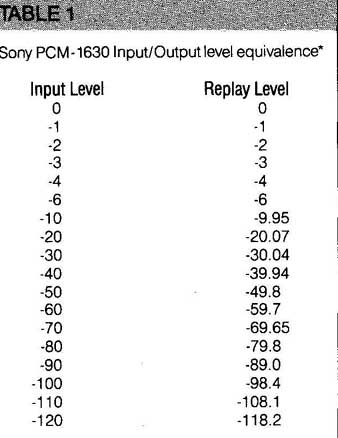We examine the performance of Sony’s DTC-1000ES R- DAT recorder in the context of the professional recording standard, Sony’s PCM-1630 U-matic recorder.

Specifications (Sony DTC-1000ES R-DAT): two-channel, rotary-head, self-contained digital tape recorder (does not require a separate tape transport). Sampling frequency: 48kHz (will also record/replay at 32kHz and replay at 44.1kHz). Quantization: 16-bit linear. Data transmission rate: 2.46Mbits/s. Subcode capacity: 273.1 kbits/s. Modulation system: 8-10 conversion. Error correction: Dual Reed-Solomon. Frequency range: 2Hz-22kHz. Dynamic range: greater than 96dB. THD at 0dB: 0.005%. Wow and flutter: ±0.01% (weighted peak). Tape speed: 8.15mm/s. Writing speed: 3.133m/s. Head-drum diameter: 30mm. Head-drum rotation speed: 2000rpm. Tape head-drum wrap: 90 degrees. Head azimuth angle: ±20 degrees. Recording time: 2 hours. Tape type: metal powder. Tape thickness: 13um. Tape width: 3.81mm. Cassette size: 73mm W by 54mm D by 10.5mm H. Price: to be announced. Manufacturer: Sony Consumer Products, Sony Drive, Park Ridge, NJ 07656. Tel: (201) 930-1000. Product not yet re leased in the USA; review sample bought in Tokyo.
With the present furor over the launch of DAT (digital audio tape), it is worth remembering that commercial digital recorders have been with us for some time now: it is now nearly a decade since studio PCM converters were first successfully used for audio recording in conjunction with a VCR (which uses a helical spiral recording via a spinning drum to achieve the high writing speed). Such systems evolved into such relatively popular units as the Sony PCM-F1, used with the matching SL-2 000 VCR for many amateur and professional recordings, and Technics even introduced a PCM console recorder with a built-in VHS transport. Nowadays, however, with professional multitrack digital recorders becoming commonplace, the VCR method has been largely superseded by linear tape recording. Multitrack digital recorders, how ever, are very expensive, and considerable scope remains for the PCM “adaptor” type of recorder, which exploits the high information-storage density of established inexpensive video recording systems.
When a true domestic DAT system was pro posed, two systems emerged. One was based on the use of a stationary multitrack head for which thin-film technology was proposed, 20 or so parallel digital tracks being required for the data and error-protection data for a stereo audio channel. For commercial reasons, the Japanese industry wanted to get DAT onto the domestic market and apparently could not wait for the thin-film technology to mature. Rotary-head designs could deliver the required information-storage performance, but conventional VCR mechanisms were thought to be too big and noisy for serious use in a domestic audio recorder. The development of the compact 8mm video medium provided the potential for very small cassettes and tape widths. From this it was but a short step to define a unique miniature “video” type cassette, specify the complementary rotary-scan video-type recording method, and dedicate it to consumer audio recording, resulting in the R-DAT format. The design includes a synchronizing timecode to allow quite rapid access to any part of the tape and the modest head-wrap angle of 90° allows for the use of easy-loading mechanisms, as well as very fast wind speeds, at present 200 times the play speed.
The commercial result is a range of first- generation domestic machines, looking not unlike large CD players, with a similar drawer-load tray and a very similar control keyboard and numeric display. Automatic track programming is a standard feature of the R-DAT designs: once a tape has been recorded, play modes and track selection operate just like a CD player. Compared with an older PCM/ VCR system, or even the professional PCM 1630/U-matic combination, the R-DAT recorder is a joy to use, with fast-access quick rewind of 2.4s/minute (50s for a two-hour tape), and the mechanism is also reasonably quick by domestic CD standards.
Potentially, R-DAT provides the consumer with a digital recorder of near-professional quality, allowing, in theory at least, very high- quality recordings—better than large open- reel sound but with cassette convenience.
For comparison, Sony’s two-track professional machine is the PCM-1630, a unit in the $23,000 class when bought with a matching U-matic recorder. The 1630 is well established in the industry and is specified by Polygram for CD mastering. As its lab performance will show, it is something of a reference machine. I was fortunate enough to have access to a 1630 for extensive lab testing, and the results give some idea of the advances which have been made with regard to PCM recording technology. Against this background, it was instructive to subject the budget domestic equivalent, in the form of Sony’s DTC-1000ES R-DAT recorder, to virtually the same battery of tests. How would the domestic equivalent compare with the professional model at over 10 times the cost?
Sony PCM-1630
Taking the 1630 first, a look at the manual gives some insight into its internal organization. As with many professional units, the design is founded on a large, rack-mount enclosure incorporating an internal backplane (an array of vertical multi-way sockets). The electronics are carried on a number of circuit-board assemblies which slide into the enclosure from the front and plug into the backplane sockets. The enclosure constitutes the mainframe, and the backplane wiring, often quite complex, routes signals and power supplies from board to board.
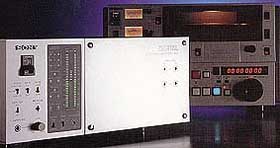
ABOVE: Sony PCM-1630 PCM processor
The two balanced input signals enter the 1630’s back via XLR sockets and semi-preset level controls, and are routed to the A/D board via 20k ohm series resistors; the first stage is a low-noise 5532 op-amp (a dual 5534) with differential input clamp diodes. Up to by RMS may be applied to this input as it is followed by a subsidiary level control, with maximum attenuation limited to 36dB. Another op-amp follows, whose frequency response is determined by an FET-switched capacitor, this the recording pre-emphasis option. Two more biFET op-amps drive the thick-film, brickwall, anti-alias filter, which chops frequencies above 21kHz; more op amps add feedback/phase correction to the filter. The filter stage for each channel is buffered by yet another 5534 op-amp, followed by the 16-bit linear A/D convert or, a Sony CX-20018, driven by three peripheral IC op amps; in this case, 356s. The digital data for both channels are then conditioned and processed on the modulator board to constitute an NTSC standard video signal ready for recording.
The 16-bit linear DAC board is Stereo, and has a considerable amount of circuitry, with Sony cx 20152 chips used for D/A conversion. Industry-standard IC regulators —7815 and 7915 types rather than the lower-impedance 317/337 types—supply the ± 15V op-amp rails, one set per channel. Many small L/C filters are present throughout the power sup plies and lines in order to filter and isolate stages from each other, suppressing the digital pulses and their harmonics.
The interesting part of the 1630, as compared with earlier professional PCM machines, is the D/A section, which employs 2x oversampling with digital filtering. It appears to owe much to the design technology of Sony’s DAS-702es domestic CD decoder (see Stereophile Vol.9 No.8 for the ‘702 and Vol.10 No.4 for the similar ‘703 decoder). Quite a lot happens to the two stereo channels after the oversampling/digital filtering and D/A con version. The output passes through LF356 op-amps,. via the logic switch deglitcher, to a “2525” IC filter stage, using inductor and feedback capacitor methods. This buffer drives the main, thick-film technology, AF LI/201, low-pass filter, this labeled identically to the record input filter. Four more ICs are present, mainly 5534s, for additional filtering, phase compensation, and dc-emphasis. The final op-amp drives two class-A/B discrete output stages per channel, one for the “hot” and one for the “cold” halves of the balanced differential output.
I have included this circuit description because I feel that it might give some insight into the sound quality of this processor. It should be noted that both the record and the replay level chains are essentially DC-coupled throughout, so questions of coupling capacitor quality do not arise. However, given that every active stage plays a part in the sound-quality chain, it is worrying to find 13 of them in the record/replay path, excluding the A/D and D/A converters. It is known that, under critical domestic listening conditions, we can hear the loss imposed by a single 5534 op-amp in a preamp line stage. considering the recording chain as a whole, if the audio has passed through a mixer console it may at best have encountered another dozen or so 5532/4 stages, or, even worse, through stages with less well-considered ICs, as well as through a number of coupling transformers. It strikes me that a lot needs to be done to improve the design practice of recording systems.
Sony DTC-1000ES
I was not able to perform an accurate head count on this R-DAT machine but from a quick look at the boards, I would estimate the number of active stages to be one third that of the 1630, while the physical signal-path length is probably a quarter, and without the need for a backplane or balanced input/outputs. Assuming a similar digital-section performance, one might expect the DTC -1000 to sound more transparent purely as a consequence of its relative simplicity
As befits its “ES” suffix, the DTC is carefully designed in the Sony Esprit tradition. The chassis is copper-plated to combat induced currents circulating in the metalwork, and the case, like that of the PCM-F1, is damped to reduce acoustic vibration. The analog and digital power supplies are separated—a clear change from the first-generation Sony CD players—and it is clear that some considerable care has been taken over the choice of components: ELNA Cerafine capacitors, for example, are used in both reservoir and decoupling applications. As with the 1630, the record section is dual-channel, using two of the same Sony CX-2 0018 ADC chips, non oversampled. There is one input op-amp leading to the good-quality Soshin anti-alias filter, a thick-film encapsulated model. Two further op-amp stages lead to the AID. Once in digital form, the coded audio is multiplexed and routed to the main digital processor, the two R-DAT chips, CXD-1008Q and CXD-1009Q. These, in conjunction with two blocks of 64k memory, handle the error-protected transfer of data to the rotary-head recorder section and back.
Once the digital data is recovered off-tape, deprocessing can begin. For replay, decoding is 4x oversampled, ultra-flat passband, high order digitally filtered and DIA converted, using Philips’s dual-channel 16-bit TDA-1541 chip at present. The final output filter is a simple three-pole Bessel type and the replay chain is linear phase. (The record section is not linear phase owing to the uncompensated input brickwall filter.) Relatively few op-amp chips are used in the filter-output section.
One small difference concerns sampling rate. The 1630 is set to CD standard 44.1kHz (or 44.056kHz). The R-DAT normally works at 48kHz, but it can decode at 44.1kHz, and will also decode and recode DBS (Direct Broadcast by Satellite) digital inputs at 32kHz. Cur rent DAT recorders have a copy-inhibit system which prevents them recording in digital mode from the digital output of a CD player if the appropriate flag is set in the CD’s PQ subcode.
Sony PCM-1630 Test Results
Sony specifies a tolerance of + 0.5, -1dB for the PCM-l630’s overall record/play frequency response; when measured with emphasis off, the result was a fine +0.2, -0.9dB from 10Hz to 20kHz (fig.1 shows the infrasonic response from 0.125Hz to 50Hz, fig.2 shows the response from 1kHz to 26kHz). The anti-alias filter came into effect above 20kHz; at 22kHz, for example, the output was already 50dB down. Considering the minor nature of the variations in frequency response, there is un likely to be an audible effect.
The two channels agreed closely on the measured parameters, and the unweighted signal/noise ratio was fine at 96dB with pre-emphasis, 90dB without. Using the CCIR ARM (1kHz) weighting, the benefit of pre-emphasis is shown more clearly with more representative record/play noise ratios of 85dB without preemphasis, 90dB with.
Full level—0dB—on the excellent level meters, indicated virtually full modulation; unlike VU-meter systems, however, there was no additional margin.
The record/replay linearity was checked using a precision spectrum analyzer over the full available dynamic range: the surprisingly good results are given in Table 1, which shows that a decent amount of dither has been incorporated to effectively linearize the low- level performance. For comparison, most CD players generate considerable linearity errors by -90dB modulation, typically 3-5dB, while errors of 10dB are not uncommon. The 1630 was 1dB accurate over the record/replay cycle at -90dB and continued to store and recover analyzed sine waves placed well into the broadband noise floor, e.g., down to -120dB. Fig.3, a ± 50Hz zoomed analysis, actually shows that a 1kHz signal can be recovered at -118.04dB, over 20dB below the cutoff point of an undithered 16-bit system! Returning to more realistic signal levels, fig.4 shows the harmonic spectrum, or should I say the lack of it, for a sinewave recorded at -90dB. Fig.5 shows the corresponding waveshape, a substantially pure one, masked by the presence of some random-looking noise.
TBL. 1: Sony PCM -1630 Input/Output level equivalence; Input Level --Replay Level
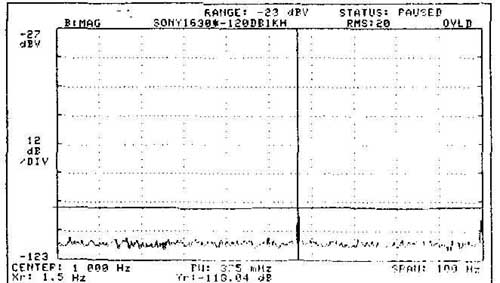
ABOVE: Fig. 3

This good distortion picture was little changed when the unit was driven to full level (fig.6, 1kHz signal at 0dB). Third harmonic at -82.5dB (better than 0.01%), for example, was the only significant product. Note the absence of digital spuriae. Reducing the level to -10dB resulted in little change, apart from the second harmonic now being higher in level (-82.7dB) than the third. Fig.7 shows the distortion spectrum and resulting alias products for a full-level 20kHz tone. This is a demanding test, but the result was really good, with the only significant in-band spurious tone placed at 4kHz (44kHz-2x20kHz) at a harmless -75.19dB. Good suppression was also seen for the 44kHz sampling frequency, with an absence of higher-frequency products. The alias products decrease rapidly both with frequency and record level.
Fig.8 shows distortion for a mid-level signal, 1kHz at -40dB, the spectrogram extending to 100kHz. The 22kHz spurious product was -95dB relative to full level, while the 1kHz distortion was around 0.07% and close to the noise floor. Other spuriae were well suppressed.
Another cruel test concerned both full-level and -10dB level intermodulation, the test signal consisting of a 1:1 mixture of 19 and 20kHz. At 0dB (fig.9), the main product was 1kHz at -71dB, a good result for a recording system, while reducing the drive level to -10dB resulted in the 1kHz product vanishing into the noise floor at -85dB.
Channel separation is important in the con text of a professional system, and here the 1630 confirmed its competence, exceeding 100dB from 20Hz to 20kHz: typical measurements were 20Hz, 117dB; 1kHz, 119dB; 20kHz, 103dB.
A fine performance was seen in the replay of a 400Hz squarewave with a sensible rise- time (fig.10). The flat tops confirm the ex tended low-frequency bandwidth, with quite moderate ringing. When the input was driven with a fast-risetime (bus) impulse, the input alias filter rang quite hard, and the output was not linear phase (fig.11). However, it was non- inverting.
These results show the PCM-1630 to be a well-developed design, with no obvious technical flaws and a wide linear dynamic range. How about its domestic equivalent?
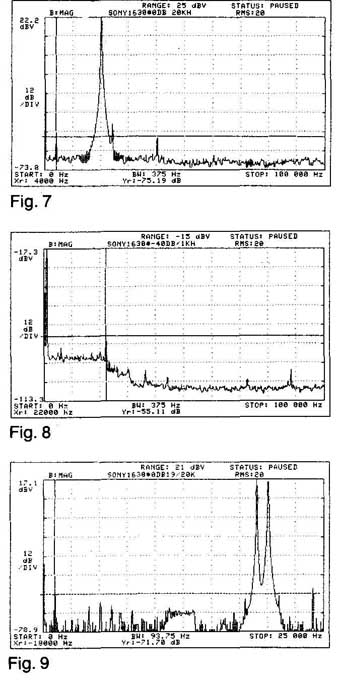
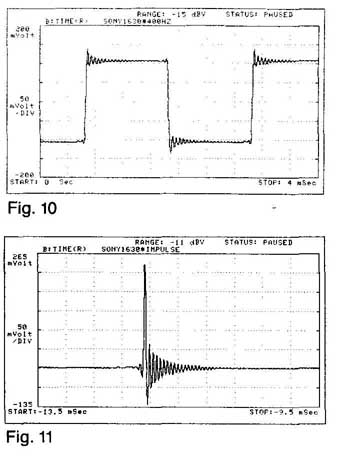
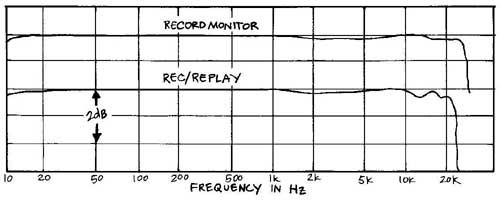
Fig. 12
Sony DTC-1000ES Test Results
To measure the record/replay frequency response, the machine was run at the standard 48kHz sampling rate without preemphasis. It held to a + 0.1, -0.35dB tolerance from 20Hz to 20kHz (fig.12), while the -0.5dB points were wide at 2Hz and 22kHz. In record “monitor” mode, the response was a little tighter at ±0.15dB. The brickwall filter point occurred at 24kHz. Channel matching was excellent, typically within 0.1dB, while channel separation exceeded 95dB over the audible range.
The full-level midband harmonic distortion was considered excellent at -90dB, 0.003%. With the input level turned down to -60dB (fig.13), the analyzed distortion spectrum showed no visible harmonics. The computed reading was -47.62dB, but this was merely noise.
Given a theoretical 96dB dynamic range for a 16-bit system such as this one, the measured distortion for a tone at -60dB should be -36dB, yet nothing can be seen (fig.l3) at -50dB, below the measurement noise floor. This is reminiscent of the PCM 1630’s use of linearizing dither. Checking the DTC-l000 for record/replay transfer linearity, we got the results in Table 2. Again, as with the 1630, if a 16-bit system “stops” at -96dB, how come these machines can encode and decode accurately at -110dB? Certainly a straightforward 16-bit linear system could not do this, but neither the 1630 nor the 1000 are such systems. With dithered encode, the effective linearity is improved by the order of 3 bits, or 18dB, while both machines offer better than 16-bit replay via oversampling, 2x for the 1630, 4x for the DTC. Even so, this still does not fully account for the excellence of the low-level resolution featured by these machines. I cannot see now how objections to the low-level linearity and resolution of digital can be sustained, at least regarding machines such as these, since it is so clearly superior in this respect when compared with other media.
To confirm the R-DAT’s resolution, a sinewave was recorded at -90dB. Fig.14 shows that on replay, a real sinewave, albeit noisy, is returned. Few CD players can match this performance.
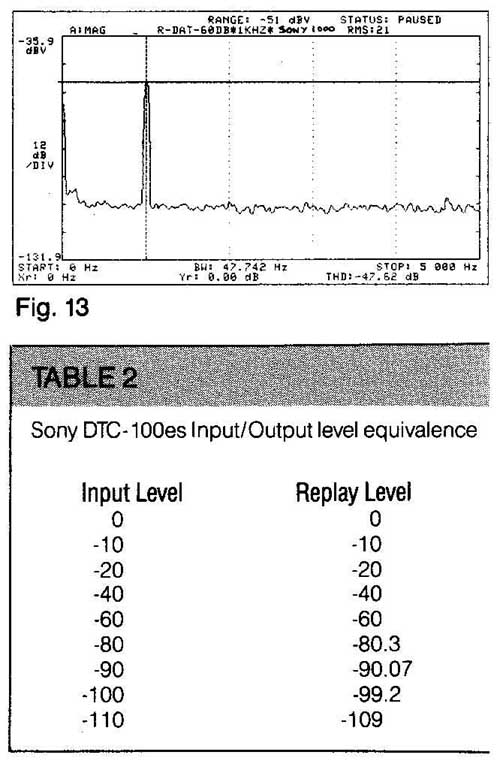
TBL. 2: Sony DTC-100es Input/Output level equivalence; Input Level -- Replay Level
To check the high-frequency performance, the recorder was driven to 0dB at 20kHz, with a fine result (fig.15). The main modulation product at 8kHz (48kHz-2x20kHz) was well suppressed at -77dB, and decreased very rapidly with decreasing input frequency. However, the ultrasonic (inaudible) product at 28kHz (48-20) was at a higher level of -53dB. Complementary measurements for two- tone high-frequency intermodulation gave equally fine results: -74dB for full level and -82dB at a -10dB test level. Using a -60dB 1kHz signature,” the spurious upper-range signals were assessed up to 100kHz. 48kHz was the sole component of significance, set at a fine -100dB, relative to full modulation.
The machine delivered an unweighted record/replay S/N ratio of 91dB; this was 93dB with CCIR ARM (1kHz) weighting, which compares favorably with the professional machine Moreover, the overall linearity and resolution figures were also comparable, with full-scale resolution approaching 15.5- bit, and an effective low-level linearity of near 17-bit.
Absolute-phase correct, the DTC-l000 also showed negligible phase shift between channels, with a maximum of 10 noted at 20kHz. The 400Hz squarewave response (fig.l6) revealed a most tidy result, non-linear phase, but with quite moderate ringing and overshoot (18%). An extended low-frequency response with low associated group delay was indicated by the waveform squareness.”
Digital recording systems have been criticized in the past for poor clipping performance. The DTC1000 was driven into clip with a 1kHz signal: fig.17 shows the replay result. As can be seen, there are no missing codes, no sharp transients or spurious effects—just clean, vice-free, “analog style” clipping. On music it sounded much as it looks here, with a surprisingly mild audible impairment for moderate (up to 6dB) overloads.
Considering that R-DAT has various technical complications such as servo azimuth and the usual clock/timing reinsertion, it was decided to put the Sony claim for wow and flutter to test: namely ± 0.01% weighted peak. With the IEG 62 DIN peak weighting, the record/replay value was established at ±0.005% (± 0.002). Given that analog tape systems produce relatively high levels of flutter sidebands as well as modulation noise, and remembering that, potentially, R-DAT represents the domestic cassette standard of the future, a narrow-band spectrum analysis was made of the 3.150Hz replayed tone to assess its pitch stability and noise-modulation performance (fig.18). With a total span of 25Hz and an analyzer resolution of just 0.238Hz, the first modulation shoulder was as close as 1Hz from the fundamental at a superb 78dB down. The spectral analysis was pure, and no wow components were evident. Compare this with the equivalent result for a good cassette deck (fig.19: note that the span is now ± 200Hz, a factor which is kind to the analog machine). Here one might be forgiven for wondering whether compact cassette is capable of holding true pitch at all! I believe that these differences are audible, aurally telling over several minutes of well-tuned piano rather than on a short A/B basis.
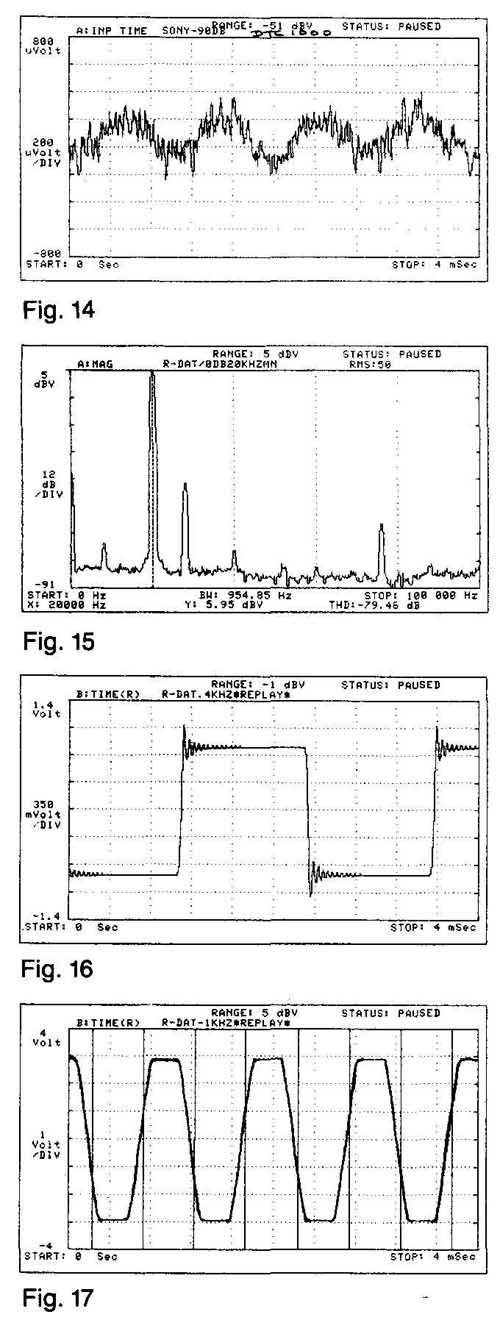
Fig. 14
Fig. 15
Fig. 16
Fig. 17
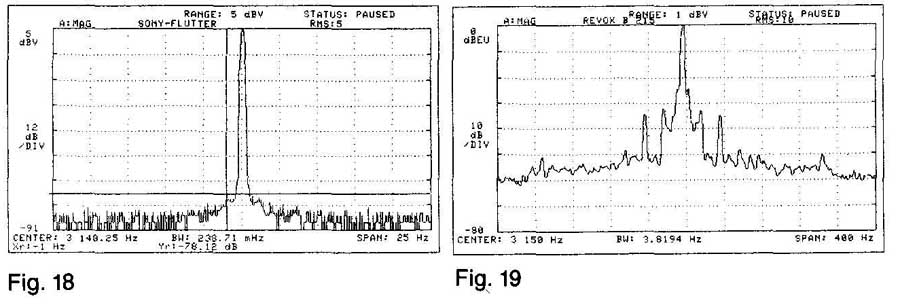
Fig. 18
Fig. 19
Absolute speed was held at 0.01%, and the record/replay tape encoding and error correction was such that one was largely unaware of whether the signals were off-tape or monitored. (The “monitor” line passes through most of the processor circuitry)
Like CD, the 0dB output level was 2 volts, sourced from a low 364 ohms. A 300mV input will drive the DTC-1000 to full modulation via an unbalanced 50k ohm input (there are no microphone inputs). With a fast-wind time of 27 seconds for an hour of tape, access to individual time-coded tracks was comparatively rapid—one of the fastest tape-handling systems I have used.
Sound Quality
Any representation of the sound quality of a recording system is more complicated than might at first appear. Out in the real world, with live music, the sound quality available as a direct feed from a good microphone transcends that generally replicated and available to the consumer. So good is this quality that, even with the losses imposed by relatively primitive recorders, much still remains. Arguably the recording technique and the performance itself -are far more important than the recorder used for capture and storage.
In this context, it must be said that well- designed digital recorders can do a very competent job. Fine results have been obtained and can be demonstrated from many decks, including Sony’s PCM-F1, PCM-701es, DTC 1000es, and PCM-1630. In fact, there is little to choose between them on replay merit. All were free from spurious noise, wow, and flutter; none suffer from high-frequency compression, or irregularities of frequency response or channel balance. Still more important to the operator, no specific tape selection or alignment is necessary, as the replay quality is essentially tape-independent.
In objective terms, the overall sound quality of one of these digital PCM units exceeded that of the channels of a typical modern multi-track mixer; most studio engineers regard digital recording as virtually perfect for this reason. It is worth noting that the $2000 domestic PCM unit essentially equals the sonic performance of a professional machine costing in the region of $23,000; in this respect, competent digital audio is a great leveler. One might then question the sound quality of a studio multi-track console.
However, we can also adopt an alternative standpoint, and place the so-called “perfect” or “nearly perfect” digital recorder in a high- quality audio chain. It can then be regarded as performing as a unity-gain amplifier with programmable time delay! What does it then sound like in a top-class domestic system? Well, if viewed as a preamp line stage and interposed between one’s existing preamp or a good CD player, then the inevitable loss in quality may be put in understandable terms. To define the context, assume that, for the present, I scale subjective audio quality for electronics in the range 0-15, with the top score as present state of the art, “0” a large table radio, and “3” a good budget rack system. Competent-sounding audio lies in the 7-11 range.
Top CD sound scores 12.5 at present: against this score, the PCM machines’ record/replay cycle achieved ratings between 6.5 and 7.3 when inserted into the reference system, a surprisingly small spread.
Given this modest rating, the sonic differences between PCM5 were not particularly significant, the main differences concerning an easier, sweeter sound, with an improvement in stereo perspectives noted with the R-DAT and PCM-1630 when compared with the earlier non-oversampled PCM-7Oles. Overall, there was a consistent loss in dynamics and drama, a softening of bass definition, and a reduction in transparency, stereo depth, and treble detail. These effects, however, were not identifiably ‘digital” in nature: if anything, they related to the usual losses encountered with some of the more complex electronics of the high-tech” preamplifiers from major Japanese companies.
A grade “10” CD player, recorded and re played through any of the PCM units, ends up at grade 6.5 to 7—clearly, no audiophile will record CD via the analog domain on to R-DAT except for background-music purposes. In theory, direct digital recording is possible, since the R-DAT will operate at a 44.1kHz (CD format) sampling rate, as well as 48 and 32kHz; given a good, CD-quality equivalent replay section in the recorder, it would be able to record and replay with fidelity equal to CD. This, however, has been blocked by the “copy prohibit” instruction encoded on CD and obeyed by domestic R-DAT recorders.
The additional proposal pioneered by CBS, concerning a spoiler code to be imposed on all records, consists of an intermittent 300Hz- wide notch, 60dB or deeper, at 3840Hz (see discussion elsewhere). CBS claims this to be inaudible, but many industry experts judge it to introduce a degradation in fidelity. Future R-DAT recorders may be forced by law to incorporate circuitry to recognize the presence of this notch and refuse to record. Consumers would thus be prevented from exploiting the true potential of a domestic digital recorder as a rightful component in a digitally based home audio system. At the very best, the CBS Copycode proposal must be carefully assessed. If it is recognized, as I think it should be, as a threat to fidelity, it should be stopped.
Comment
The domestic R-DAT format is a successful piece of design and engineering: as typified by this Sony machine, it works very well, with no- identifiable code errors, low mechanical noise, convenient tape/time access, and—in con text—good fidelity The lab performance was most impressive, and closely approached the professional equivalent. The latter, Sony’s PCM-1630, shows just how far commercial digital recording technology has come in terms of dynamic range, low-level linearity, and general accuracy. For semiprofessional recording, however, an R-DAT machine would do nearly as well, matching the performance of the full-sized system for simpler productions. If switched to 44.1kHz (some internal modifications are needed, modifications that would be subject to a $50,000 fine under the bill currently before Congress), it could be used for the first stage of CD mastering.
Considered as a hi-fi component, Sony’s DTC-1000es R-DAT works admirably. Nevertheless, two major questions arise. First, why doesn’t the recorder at least match the perceived quality of a good CD player? There is an interesting idea of precedence and logic here. Second, if the copyright constraints pre vent effective domestic use of an R-DAT ma chine except for occasional live recording, thus restricting replay to as-yet-poorly planned prerecorded tapes, what could the machine be used for?
Taking the first point, we have to remember that assessing the sound of a PCM as a complete line stage is illogical, since normally (hopefully!) we would encode once and the replay/decode would be via a CD player with a digital input (the handbook for the 1000 illustrates use with Sony’s DAS-703es). Thus this test is unrealistically arduous. Nevertheless, some of the shortfall, in my view, is not the fault of the digital part of the process but is tied up with the rather lengthy cascades of audio chips used between the input and the outputs of a PCM system. Certainly the simpler consumer models—the PCM-701es, DTC-1000es, sounded “sharper” and more dynamic than the more complex 1630. Improvement in this area is a function of good audio systems engineering, and I suspect that there is considerable scope here.
As regards the second question, I believe that R-DAT is a clever design lacking in mass-market consumer relevance, and is emasculated in terms of its digital interfacing. Perhaps the Japanese Electronics establishment believed that anything with "Digital Audio” on it would sell. At present, R-DAT decks are big and ex pensive, while tape prices are higher than those of compact cassette. (3M has announced that its 120-minute tape will cost $12.) Pre recorded material hardly exists, and in any case is only compatible with itself! DAT certainly has a future, but at present it must be considered a long-term one, with possibly five years before worthwhile sales, and 10 before dominance of the quality cassette market. As for CD sales, I think that they will be largely unaffected. Surely R-DAT represents the recipe for minimal sales of a new technology.
